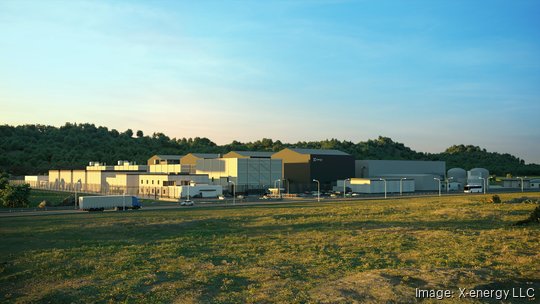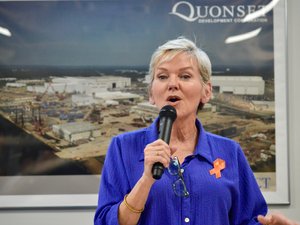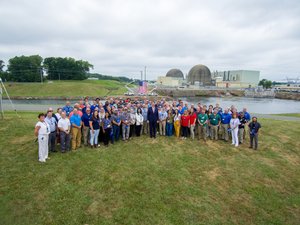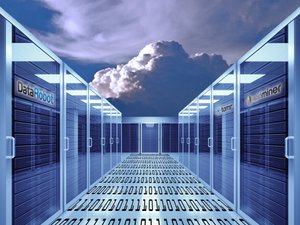
Nuclear power is widely seen as a solution to increasing electricity demand for data centers — and tech companies are taking note.
On Monday, Google LLC signed an agreement with Alameda, California-based Kairos Power to supply its data centers with nuclear energy in the coming years.
Then, on Wednesday at its headquarters in Arlington, Amazon.com Inc. signed an agreement with utility giant Dominion Energy Virginia to pursue new nuclear innovations in the commonwealth. It led a $500 million funding round for Rockville startup X-Energy Reactor Company LLC, a developer of small modular reactors and nuclear fuel technology.
For Google and Amazon, these small modular reactors, or SMRs, could be the key to reliable, high-energy demands that data centers require, especially in an era where artificial intelligence-based tech is sucking up even more electricity.
SMRs, designed to be deployed on-site at data centers or other customers, can produce the same constant and reliable clean power that a typical nuclear plant offers but with a much smaller footprint, lower capital costs and quicker build times. Their adoption could have ramifications for the hundreds of data centers found throughout Northern Virginia.
As part of its role to increase SMR deployment nationally, the federal government this week opened applications for $900 million in funding it's making available to help companies implement SMRs, part of a national incentive to better compete against countries that are further ahead with rolling out these power sources like China and Russia.
"We want to take down the mystery and make sure that the investment world understands the importance of this technology and its likelihood of success," U.S. Energy Secretary Jennifer M. Granholm said during Amazon's nuclear event. "Ultimately, I think what we're starting here is a race to the top, and the bigger and bolder these companies dream, the greater the rewards will be for all of us."
While no SMRs are currently deployed in the U.S., their eventual use for on-site power supply would alleviate strain on the national grid at a time when utility providers are struggling to meet demand. In Virginia alone, home to more data centers than anywhere else, it's estimated that 20% of the state's power is being used by these computing warehouses, a figure that's only expected to grow in the near future.
"Small modular reactors are a huge piece of how we're going to solve this puzzle of getting to 100% clean electricity by 2035 while responding to all of the demand that will be created as a result of the data centers and the new factories, etcetera, that are coming online,” Granholm said.
What is an SMR?
Small-scale nuclear energy use dates back to the emergence of nuclear-powered aircraft carriers and submarines in the late 1950s and early 1960s. By using nuclear energy, as opposed to diesel or other quick-burning fuels, ships could remain at sea for years at a time, but the reactors had to be designed to meet the stricter space limitations of a naval vessel instead of a sprawling power plant complex.
The SMR concept builds off of that premise and is designed to be manufactured in a factory-like setting for shipment and installation on the site of its intended customer like a data center or manufacturing site, according to the International Atomic Energy Agency. There are dozens of types of SMR designs but most can be classified as either light water or sodium fast reactors, which refers to the type of solution that the nuclear fuel is cooled in amid the energy production process.
How big are SMRs?
The "small" in SMRs is about its size compared to a traditional nuclear power plant, so don't expect these facilities to pop up in the backyards of homes or offices.
These facilities can generate up to 300 megawatts of power — enough power for nearly 50,000 homes — per reactor and are designed to scale to meet the needs of their target customers. For example, Hyperscaler data centers, which can be more than 100,000 square feet, could see energy demands between 20 megawatts and over 100 megawatts of power. According to the Idaho National Laboratory, one of several federal nuclear research sites, a proposed SMR from Portland-based NuScale would span 35 acres and generate 920 megawatts of power, about half the size a traditional nuclear power plant occupies.
Why now?
Ashburn District Supervisor Michael Turner is intimately familiar with the energy demands of the roughly 200 data centers found throughout Loudoun County. The recent emergence of tech powered by artificial intelligence is only exacerbating that demand, he said, as some data center owners are now installing on-site natural gas generators since energy demands aren't being met by utility providers.
"The industry has gone through a historic change, literally in the last two years," Turner told me during an interview. "Up until then, electricity was an unlimited commodity. Two years ago was the first time that the energy demands went through the roof, and we were suddenly faced with utilities not being able to deliver that energy."
He's convinced SMRs will be the solution in the years ahead due to their ability to provide constant, low-emission power. He also called for better coordination between federal, state and local entities to address the challenges being posed by the rapid growth of data centers over the past decade.
"I have not been in a data center conversation in the last year where I did not say 'I think we're going to nuclear,' where the data center people just nodded their heads," Turner said. "They know exactly where this is going."




